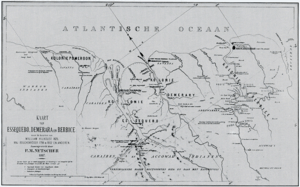Capture of Demerara and Essequibo
The capture of Demerara and Essequibo was a French military expedition carried out in January 1782 as part of the Anglo-French War. In 1781, Admiral Lord Rodney sent two sloops from his fleet at Sint Eustatius to take possession of the Dutch colonies of Essequibo and Demerara. In 1782, the French successfully took possession of these settlements, compelling British Governor Robert Kinston to surrender.[1] The Peace of Paris, which occurred in 1783, restored these territories to the Dutch.[1]
Background
In December 1781, Great Britain declared war on the Dutch Republic, bringing it formally into the 4th Anglo-Dutch War. In early 1781, a large British fleet, under Admiral Lord Rodney, was sent to the West Indies. After making seizures in the Caribbean Islands, Rodney sent two sloops to take possession of the colonies of Essequibo and Demerara. The possession was taken without much difficulty.[2] The colonies had already de facto surrendered to six British privateer ships by the time the two naval vessels arrived. The governor, Van Schuilenburg, was not satisfied by Dutch protection and surrendered to the British, who found a rich booty in the colonies from the vast quantity of produce which had accumulated due to a lack of shipping.[2]
French capture
French naval Captain Armand Guy Simon de Coëtnempren, Comte de Kersaint, with his 32-gun flagship Iphigénie and four lesser ships, arrived at Demerara without much opposition. There, 335 French men from the Regiment Armagnac and the 1st Legion Volontaires étranger de la Marine launched an assault on the British garrison and compelled Gov. Robert Kinston and his detachment from the 28th Regiment of Foot to surrender. As a result, Essequibo and Berbice also surrendered to the French on 1 and 5 February.[4]
The French seized five Royal Navy vessels: the 20-gun Orinoque (Commander William Tahourdin), 16-gun Barbuda (Commander Francis Pender), 18-gun Sylph (Commander Lawrence Graeme), 16-gun Stormont (Commander Christmas Paul), and 16-gun brig Rodney (Lieutenant John Douglas Brisbane).[3]
Aftermath
The Comte de Kersaint became governor of the three rivers and their settlements and inhabitants. To guarantee their conquest, the French began to construct forts at the mouth of the Demerara River, one on each eastern and western bank, and for that purpose, they compelled the planters to furnish slave labor. They also doubled the capitation tax. These burdens were felt severely by the colonists. The Peace of Paris, which occurred in 1783, restored these territories to the Dutch.[5] When Demerara surrendered to the French, the British naval commander, being at that place, signed the capitulation. Gov. Kingston's proposals for terms contained the following rather singular proposition:
| “ | "The Lieut.-Gov. for himself requires, that not having troops with him, he may be considered in a civil capacity, and at liberty to join and do duty with his Britannic Majesty's 28th Regt., of which he has the honor to be Lieutenant-Col."[2] | ” |
To this the following answer was returned:
| “ | "Lt.-Gov. Kingston having retired himself to his Britannic Majesty's squadron, from whence he has made his particular proposals which were rejected, I cannot but consider him in a military capacity, jointly with the commander of the squadron."[2] | ” |
Notes
References
- Henry, Dalton G. (1855) The History of British Guiana: Comprising a General Description of the Colony: A narrative of some of the principal events from the earliest period of products and natural history.
- Hadden, James (2009) Hadden's Journal and Orderly Books. (Applewood). ISBN 1-4290-1685-X
- Cust, Edward (1862). Annals of the Wars of the Eighteenth Century, Compiled from the Most Authentic Histories of the Period. 3. John Murray.
- Chartrand, Rene (1992) The French Army in the American War of Independence. (Osprey). ISBN 1-85532-167-X
- Marley, F. David. (1998) Wars of the Americas: A Chronology of Armed Conflict in the New World, 1492 to the Present. (ABC-CLIO) ISBN 0-87436-837-5
